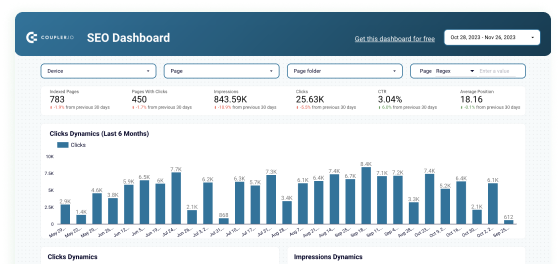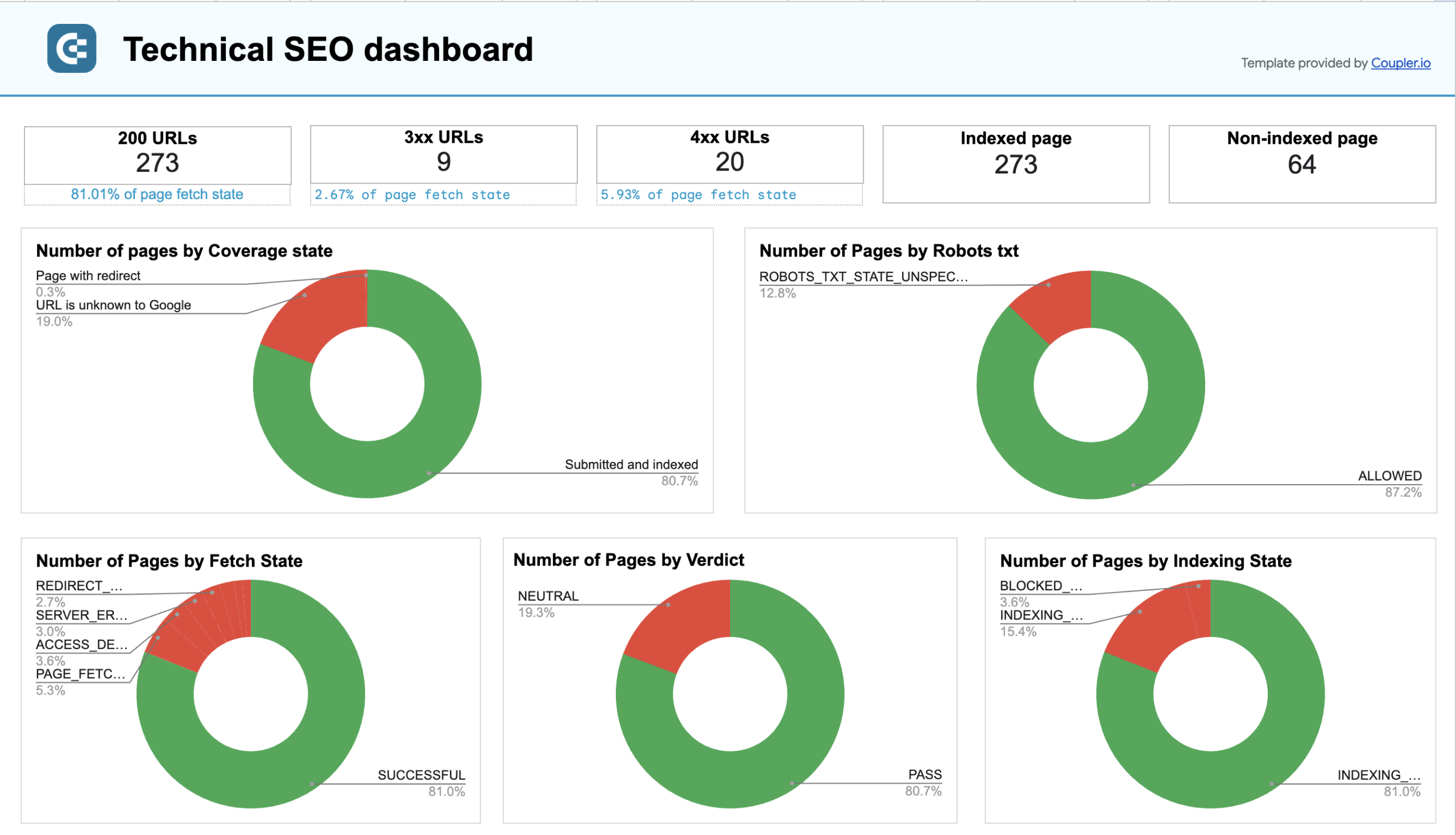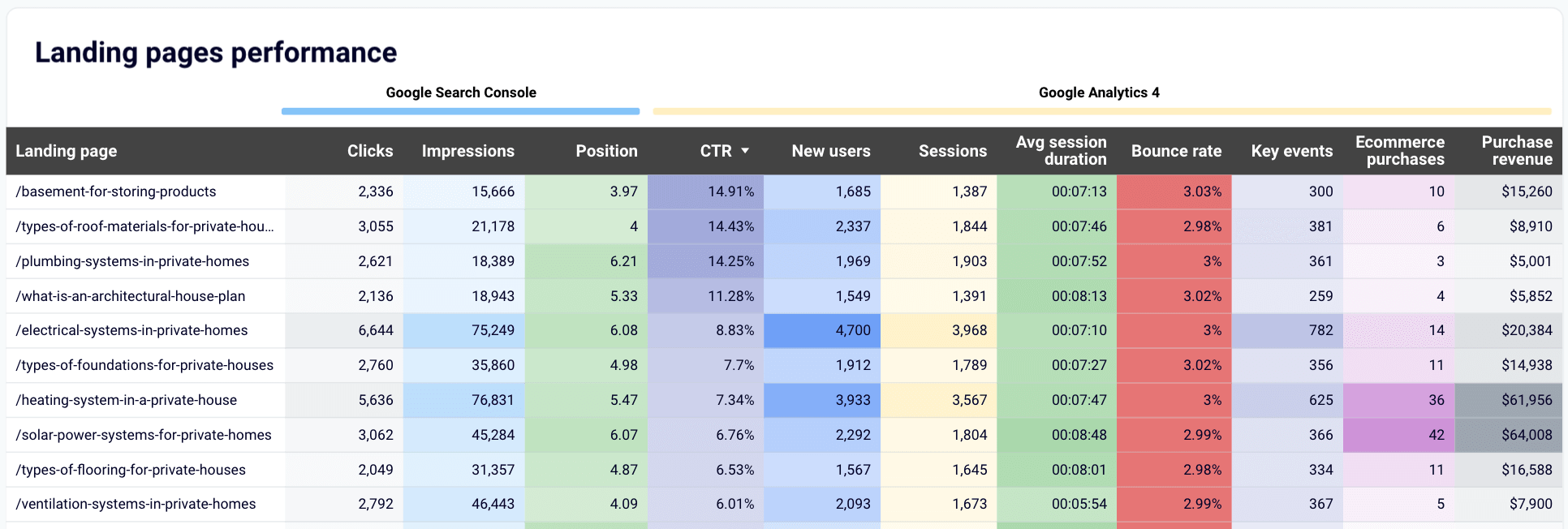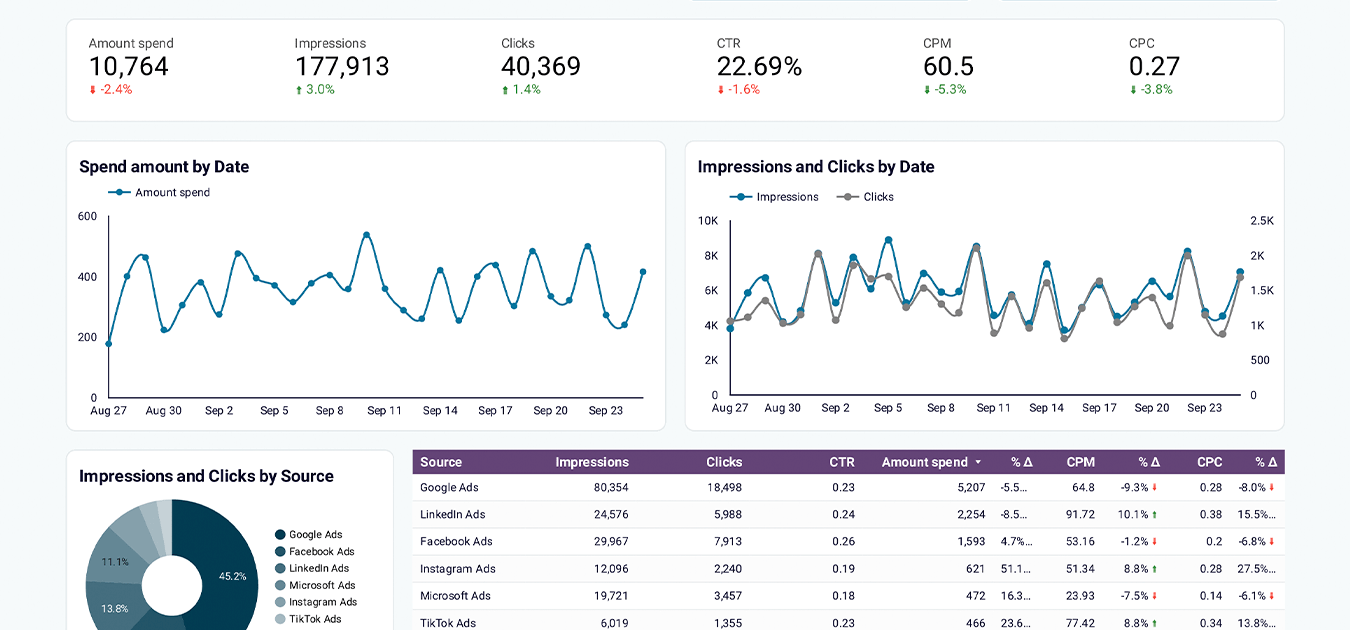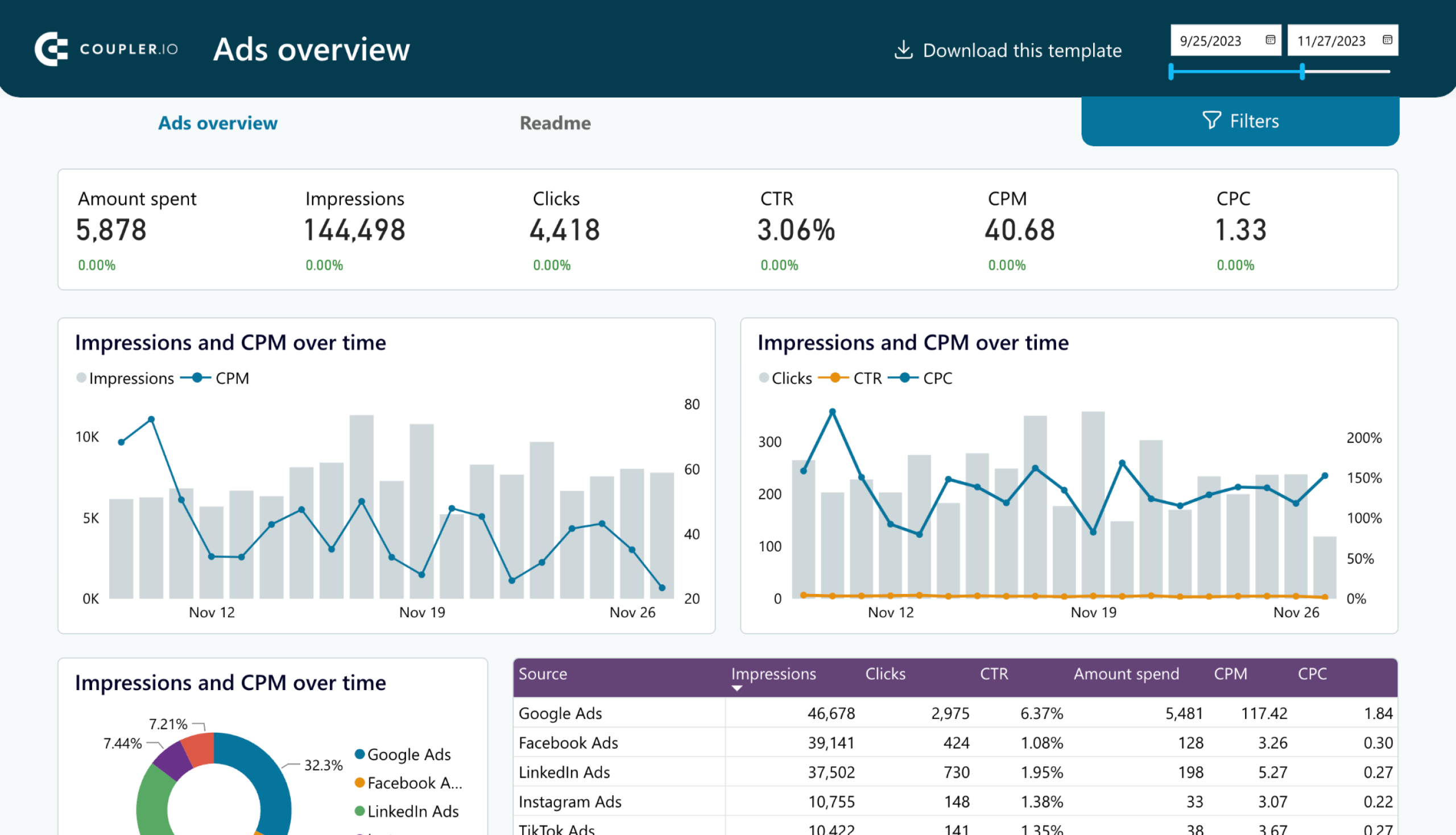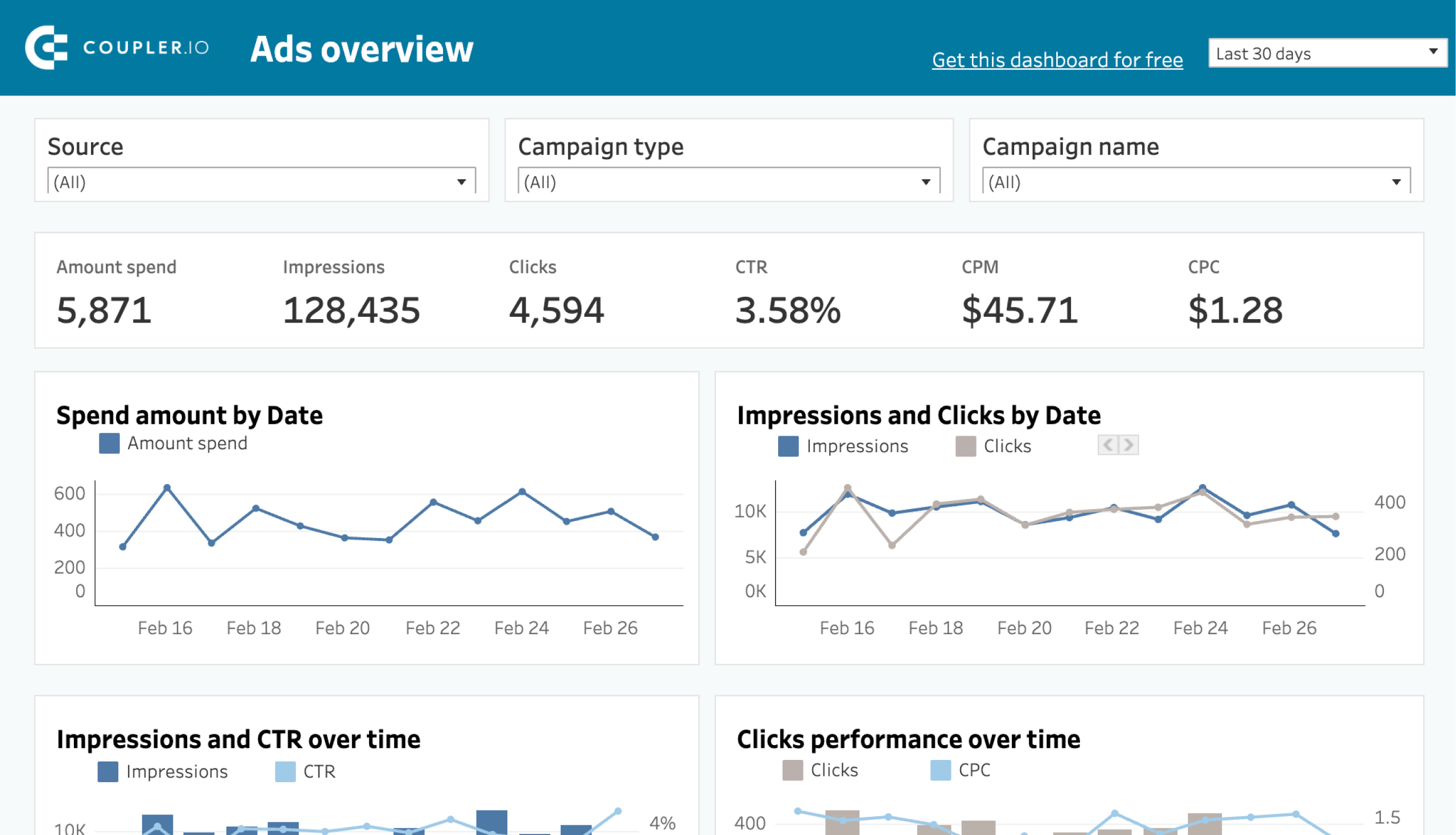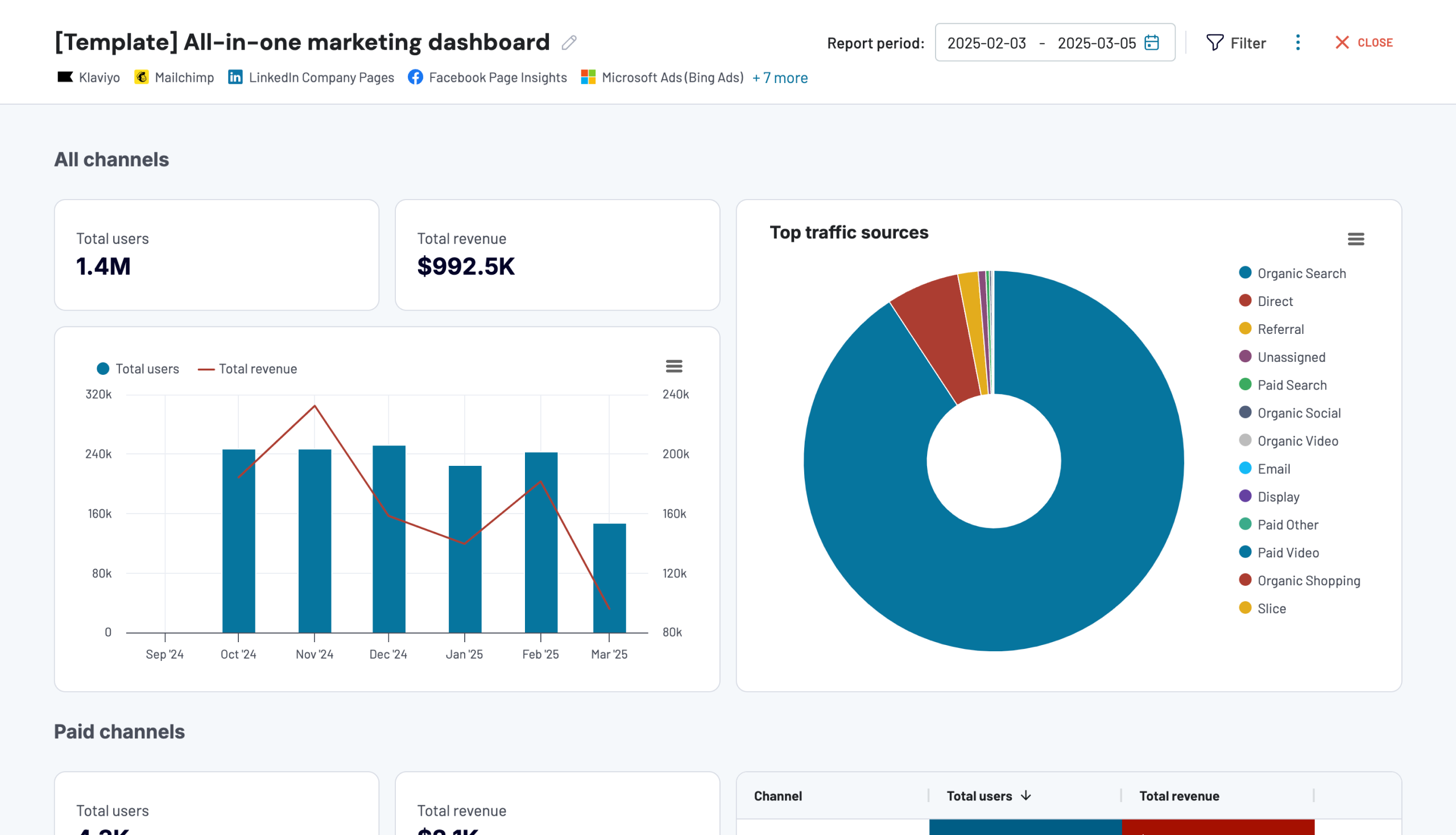Both SEO (Search Engine Optimization) and PPC (Pay-Per-Click advertising) are strategies designed to increase your website traffic, but they can serve different purposes.
SEO focuses on improving organic ranking while PPC is all about paying for targeted traffic.
In this article, we take a closer look at the main differences between SEO and PPC, when to use each strategy, and how to measure their effectiveness.
SEO vs. PPC: What’s the Difference?
Search Engine Optimization (SEO) is the process of building and optimizing a website and its pages to improve its visibility in organic search engine results, such as Google or Bing.
With the rise of AI-based search tools like ChatGPT, Gemini, Claude, you name it, SEO also includes optimization for conversational and generative AI responses.
Pay-per-click (PPC) is the practice of bidding for keywords that will show your ads at the top of organic search results.
The main differences between SEO and PPC strategies are the time and money needed to generate results.
Reports suggest the average ROAS for Google Ads is 2:1, meaning you will earn $2 for every 1$ spent.
If we look closer at Google’s assessment of the economic impact of ads, their methodology suggests you can see returns as high as $8 for every $1.
This will, of course, vary by industry. Here are some benchmarks you can use for guidance:
| Industry | PPC ROAS | PPC Time | SEO ROAS | SEO Time |
|---|---|---|---|---|
| B2B SaaS | 1.7 | Fast results, scalable based on budget | 8.75 | 3-6 months to start seeing traffic |
| Financial Services | 1.05 | 11.1 | ||
| E-Commerce | 2.05 | 3.65 | ||
| Legal Services | 1.55 | 6.15 | ||
| Software development | 1.9 | 7.3 | ||
| Automotive | 1.2 | 12.1 |
Check out this wider collection of PPC benchmarks, including industry averages for click-through rates, CPC, and more.
Before we cover both strategies in more detail, let’s look at when it’s best to use each.
When to use SEO vs. PPC
Choosing between SEO and PPC depends on your goals and available resources, both financial and human.
SEO is best when you have expertise to share around topics your audience is searching for. It’s a long-term growth plan that requires a limited budget to get started and is focused on building authority in the industry.
PPC, on the other hand, is best for fast results when you need immediate visibility. It’s ideal for new product launches and assessing market demand.
Use SEO when:
- You have internal expertise in content creation and optimization.
- Your marketing budget is limited, but you can invest time.
- You’re focused on long-term growth.
- You don’t rely on generating quick results.
- You can create valuable content for your users based on your expertise.
- You want to build authority in your niche.
- Your audience seeks in-depth information and educational content on the topics you can cover.
Use PPC when:
- You need fast brand exposure and quick results.
- You have a consistent ad budget to invest monthly.
- You have a clear acquisition funnel with positive ROAS.
- You’re launching a new or unique product.
- You want to test market demand quickly and validate marketing hypotheses.
What is SEO?
Search Engine Optimization (SEO) is the ongoing process of improving your website’s visibility in organic search results through content creation, technical optimization, and authority building.
The end goal of an SEO strategy is generating organic traffic that will drive conversions. The key components of it include:
- Keyword research: Identifying relevant keywords (user search queries) that your content should focus on.
- On-page SEO: Optimizing website navigation and on-page engagement metrics to improve user experience.
- Off-page SEO: Building trust and domain authority through backlinks from other websites.
- Technical SEO: Making sure search engine algorithms can find, crawl, and index the content you create.
Learn more about the difference between in-house vs. agency SEO.
Pros and cons of SEO
| Pros | Cons |
| Cost-effective in the long run without per-click costs | It takes time to start ranking and bring in traffic |
| Improves brand credibility and trust | You need qualitative content to not diminish your brand |
| It gets you compound returns over time | Can be negatively impacted by search ranking algorithms |
| It brings traffic for multiple keywords | Ranking for some keywords can be highly competitive |
SEO is a good long-term investment as there are no associated per-click costs and the results compound over time.

However, the main downside of SEO is that you’re always at the mercy of algorithm changes.
These can negatively impact your ranking and the traffic your content brings.
Results will also vary based on industry as some keywords can be highly competitive, making it hard to stand out in a crowded market.
For example, if you’re a social media scheduling SaaS, ranking first for this term will mean competing with industry giants like Buffer, which has an established brand authority backed by 447K backlinks.
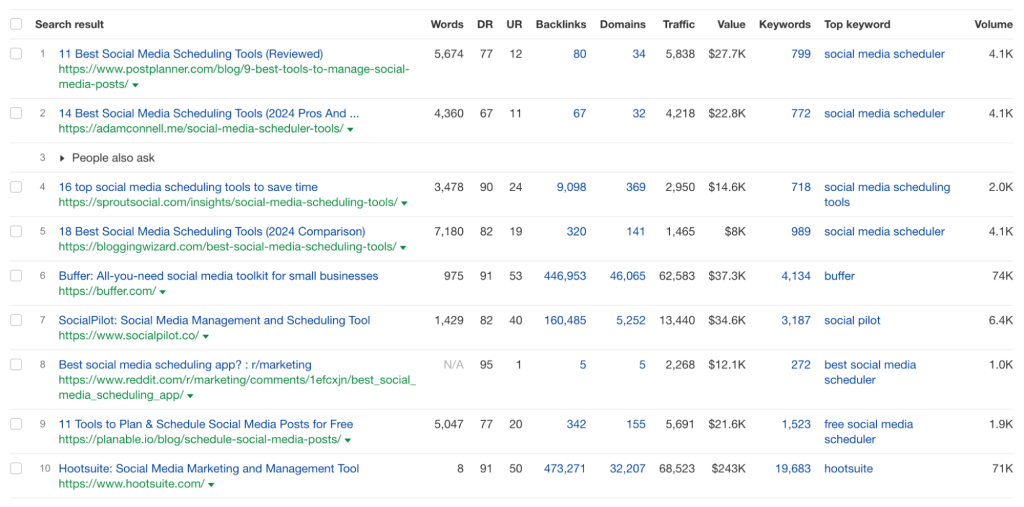
The most important SEO KPIs and how to track results
To measure SEO impact, you can look at several metrics regularly:
- Organic traffic volume and growth rate: Track how much traffic your pages generate and how many pages bring it.
- Organic traffic conversion rate: Measure how many signups, demos, or sales you generate from the organic traffic.
- Target keyword ranking position: Monitor how well your pages are ranking for the keywords most important to your business
- Click-through rate (CTR): Understand how many people click on your pages in search results.
- Page load speed and Core Web Vitals metrics: Track how well your website is optimized for the ranking algorithm and UX.
- Backlink quality and quantity: Track how many websites link to yours and how relevant they are.
Discover more about SEO analytics in our blog post.
You can use tools like Google Analytics 4 and Google Search Console (GSC) to monitor all these metrics. The downside is that you’ll need to generate multiple reports whenever you want to track different metrics.
The alternative is to pull data from these sources and build a customized SEO reporting dashboard to track specific KPIs in a single view. For example:
What is PPC?
Pay-per-click (PPC) is a digital marketing model in which you pay for your website to appear on search engine results pages or social media, depending on the PPC channel you use.
PPC marketing can generate a quick return on investment as it allows you to buy visits to your website instead of earning them organically through SEO.
The key components of a PPC advertising strategy for Google Ads include:
- Keyword research: Find relevant keywords you want your website to rank for above organic results.
- Bid setting: Decide how much you are willing to spend to rank for specific keywords.
- Ad placement: Figure out where your ads should show.
- Ad copy creation: Create relevant ad messages to compel your target audience to click.
- Paid search targeting: Set who should see your ads.
Pros and cons of PPC
| Pros | Cons |
| Immediate results to establish an online presence | Consistent monthly PPC budget management and monitoring |
| Capture relevant traffic fast with precise targeting | Expensive for some industries and specific keywords |
| Easy to scale, get more results with more budget | Results stop when ads are paused |
While you can use pay-per-click advertising to generate immediate results and establish an online presence, PPC involves ongoing costs and requires regular monitoring.
The main advantage of PPC is that you can target specific audiences for quick results while you wait for your SEO efforts to start generating organic rankings.
The downside of PPC is that some keywords can be quite expensive to bid on.
For example, the average cost per click for the “onboarding tool” keyword is $16. This is the amount you’ll pay if someone clicks on your webpage, but it does not guarantee a purchase.
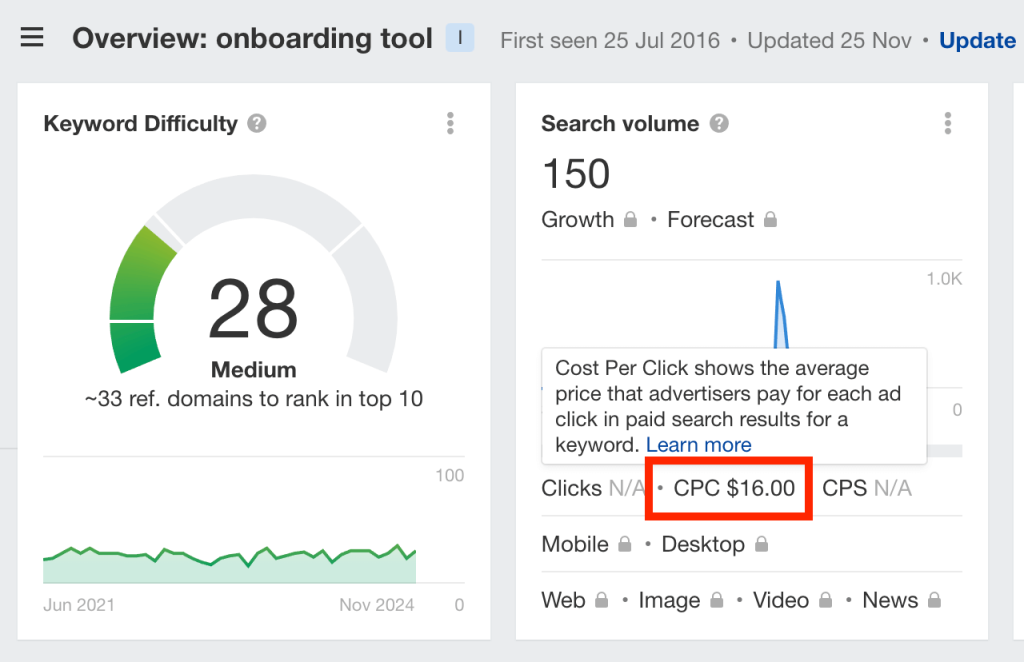
The most important PPC KPIs and how to track results
To measure search ad results and optimize your PPC reporting, track the following metrics:
- Cost per click (CPC): Track the amount you pay for each click to monitor costs and control spending.
- Click-through rate (CTR): Measure how compelling your ads are by measuring the percentage of people who click after seeing them.
- Cost per lead (CPL): Monitor the cost of acquiring a lead to evaluate the efficiency of your ad campaigns.
- Conversion rate: Understand how many clicks turn into purchases or other desired actions.
- Return on ad spend (ROAS): Measure profitability by comparing revenue generated against advertising costs.
When running Google Ads, you’ll get access to these metrics inside the dashboard.
But you’ll need to scroll through different campaigns, making it hard to understand how efficient your PPC campaigns are.
A better solution is to use a PPC dashboard to visualize the results in a more user-friendly way and derive insights into your PPC ROI.
If your PPC budget is spread across multiple channels, not just search ads, you can benefit by analyzing results using a more specific dashboard.
For example, the Google Ads vs Meta ads dashboard will help you track and compare costs and results across these channels.
SEO vs. PPC: Which is better?
When deciding between SEO and PPC, it’s important to recognize that neither approach is objectively better. The choice depends on your specific goals and available resources.
SEO is ideal for long-term growth with a limited budget but requires expertise in content creation and time investment. Opt for SEO campaigns when you can provide quality content packed with valuable industry expertise and aren’t dependent on immediate results.
On the other hand, PPC should be your go-to choice when you need short-term results, and the budget is not a concern. It can be highly effective for new product launches, assessing demand, and creating brand visibility among potential customers.
In certain industries, such as e-commerce, depending solely on SEO can mean the business takes a long time to become profitable due to the high competition.
The most effective approach for a successful search engine marketing strategy (SEM) is using SEO content marketing and PPC ad campaigns together.
SEO and PPC can complement each other and help you achieve a stronger digital presence.
How to use SEO and PPC together
Here’s how to use SEO and PPC together to get better results.
1. Use PPC to promote your most important SEO content
Writing high-quality content takes time. The key idea is that businesses should not create SEO content but optimize content for SEO.
Since SEO is a long-term strategy, it takes time and a couple of updates to get the content to rank and bring in traffic. PPC can help with this.
Run PPC marketing campaigns to drive traffic to important pages, content, etc.
This will help you get results from your SEO faster while building your brand authority.
For example, brands like ClickUp and SemRush pay to boost their blog articles written for the “best CRM software” keyword.
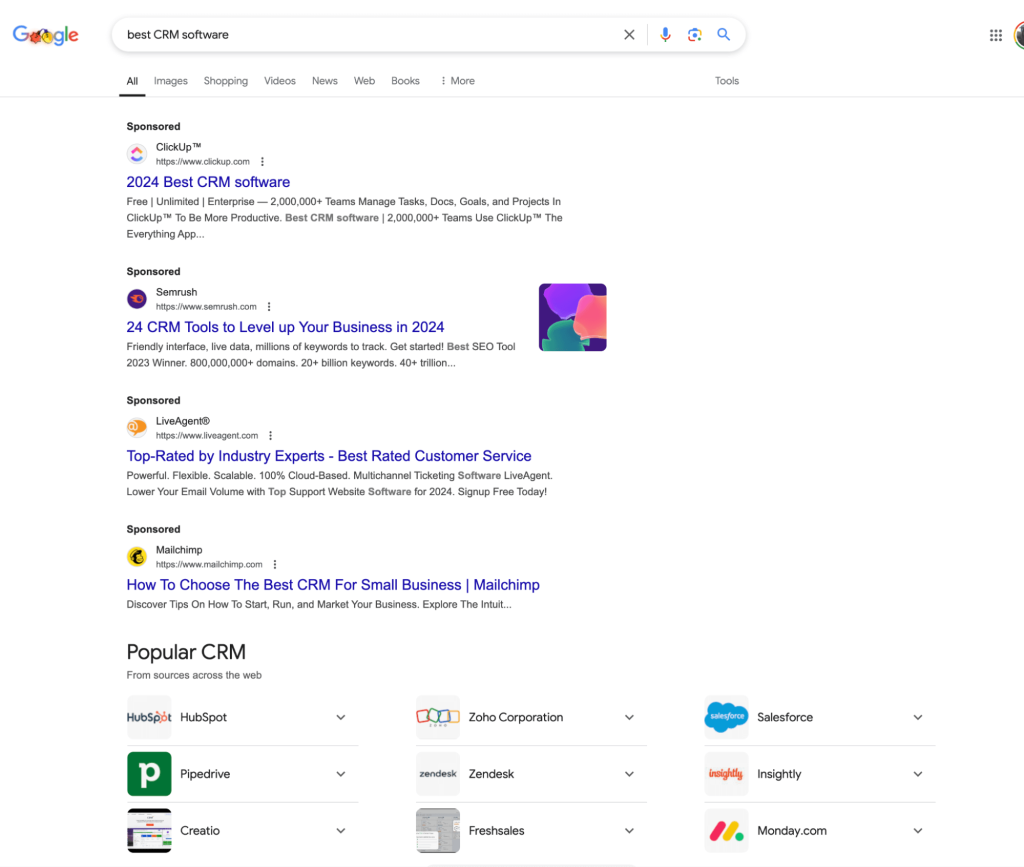
2. Retarget organic users with PPC ads
Once you start generating SEO traffic, consider building specific audiences based on which content they’ve engaged with. You can use these to target ads at users in a specific stage in the sales funnel.
For example, create an audience of all website traffic for your “tool vs tool” articles. These visitors are in their decision-making stage and can be considered ready to buy.
3. Dominate the SERP with both PPC and SEO content
Using both strategies, you can maximize your search visibility by appearing in paid and organic results at the same time.
This increased presence will boost brand credibility and the chances of a user clicking on your page.
Look at how Mailchimp is dominating the SERP with both paid and organic search results for the search term “types of CRM software”.
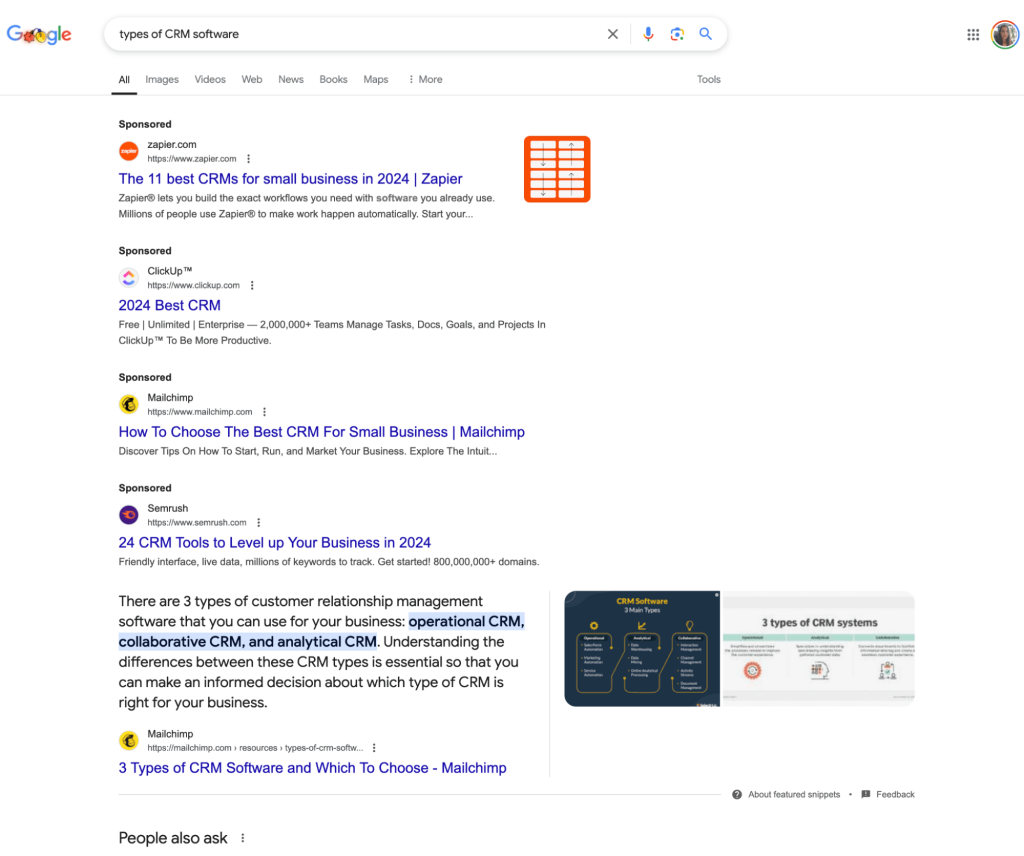
4. Use PPC to test your SEO content strategies
Before committing to long-term SEO efforts, evaluate keywords and content ideas using PPC. This works best when you want to test which keywords have the highest potential to convert users into customers.
Using PPC will get you instant feedback on what resonates with your audience. Use these insights to guide your organic content strategy.
5. Reduce high-CPC keywords ads when organic ranking increases
When you use SEO and PPC together, it’s easier to rank for more keywords while optimizing the overall costs. Once you achieve strong organic rankings, gradually reduce PPC spending on those keywords.
You’ll spend less on keywords with a high CPC, and your PPC costs will decrease as your organic presence increases.
This strategy optimizes your marketing budget while maintaining visibility in search results.
6. Get top organic positions for keywords that competitors pay for
Analyze the keywords your competitors are bidding for and target them with SEO content. This will help you capture relevant traffic without the added ongoing costs.
You can use SEO reporting tools like Ahrefs or Semrush to spy on your competitor’s paid keywords and landing pages.
For example, Ahrefs is paying for multiple keywords, as we can see in the image below.
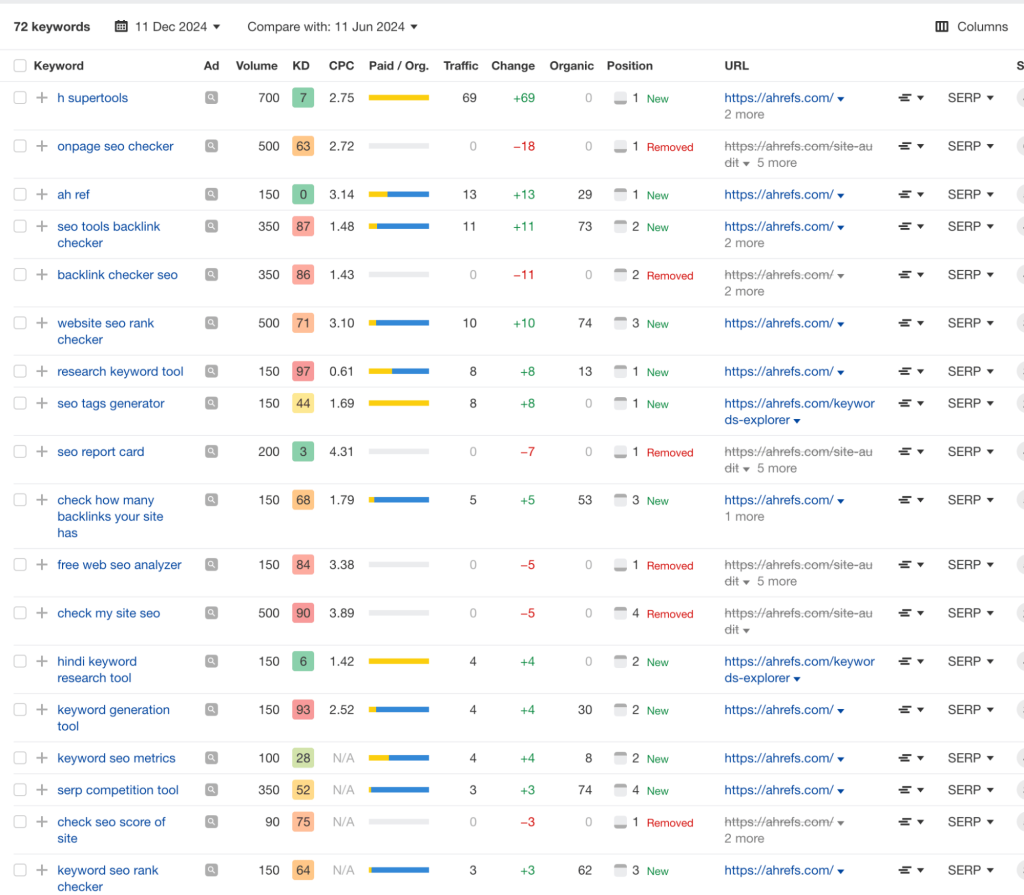
Generate a list like this for your competitor and check for keywords with low keyword difficulty (KD) to create SEO content.
For example, Semrush, Ahref’s top competitor, ranks organically for a keyword Ahrefs is paying for.
If we look at the list above, we can see the keyword “Keyword seo metrics” has a low difficulty and good search volume if we check the image above. Then checking the SERP results for that keyword, we can see Semrush ranking organically for it.

Use this strategy and identify potential keywords you could rank for that your competitors are paying for.
7. Identifying content gaps and long-tail keywords
Use PPC campaign results and analyze search terms that trigger your ads. This can help you discover niche keywords and understand the language your target audience uses when searching.
You can use these insights to create more relevant ad campaigns copy and improve targeting. Or shift the focus and target those keywords with your organic SEO efforts.
This way, you’ll be continuously refining your content strategy based on data.
8. Fast geographic targeting results
Geo-targeted PPC ads can help you test specific demographic regions before investing in local SEO.
This type of campaign allows you to validate specific markets and asses their potential. Use the results data to collect regional audience insights and determine which locations could benefit from local SEO or content localization efforts.
For example, should you bid on Spanish or German keywords? Should you translate your top-performing blogs into those languages? Running paid ads in Spanish and German-speaking locations can help you find answers to these questions.
You now know how PPC and SEO can help. To achieve great results with both approaches, you need a clear strategy that includes planning, implementation, and measurement. So far, we’ve focused on the planning and action steps—how to use SEO and PPC tactics effectively.
But the process doesn’t stop there. Since both strategies should be implemented long term, you need to also start tracking the results. Measurement and continuous improvement are key to sustaining success and making informed decisions. Here are our recommendations for the dashboards you can use for SEO and PPC analysis.
Useful dashboards to analyze SEO and PPC performance
All-in-one marketing dashboard
This all-in-one marketing dashboard is useful when you are running campaigns across multiple channels and need to understand which one is generating the best results at the lowest cost.
You can track both organic and paid traffic from multiple channels, not just Google. Use it to track total users and traffic sources as well as to understand ads performance across channels like Google Ads, Bing Ads, Meta Ads, or LinkedIn Ads.
The dashboard is available in Coupler.io and as a template in Looker Studio. Try it right away for free! Set up the dashboard by following instructions inside the template and transform raw marketing data into actionable insights.
Organic Search vs. PPC campaign dashboard
If your main acquisition channel is Google, the Organic Search vs. PPC campaign dashboard is a valuable tool. It allows you to compare your traffic, spending, and efforts across specific topics based on the type of traffic.
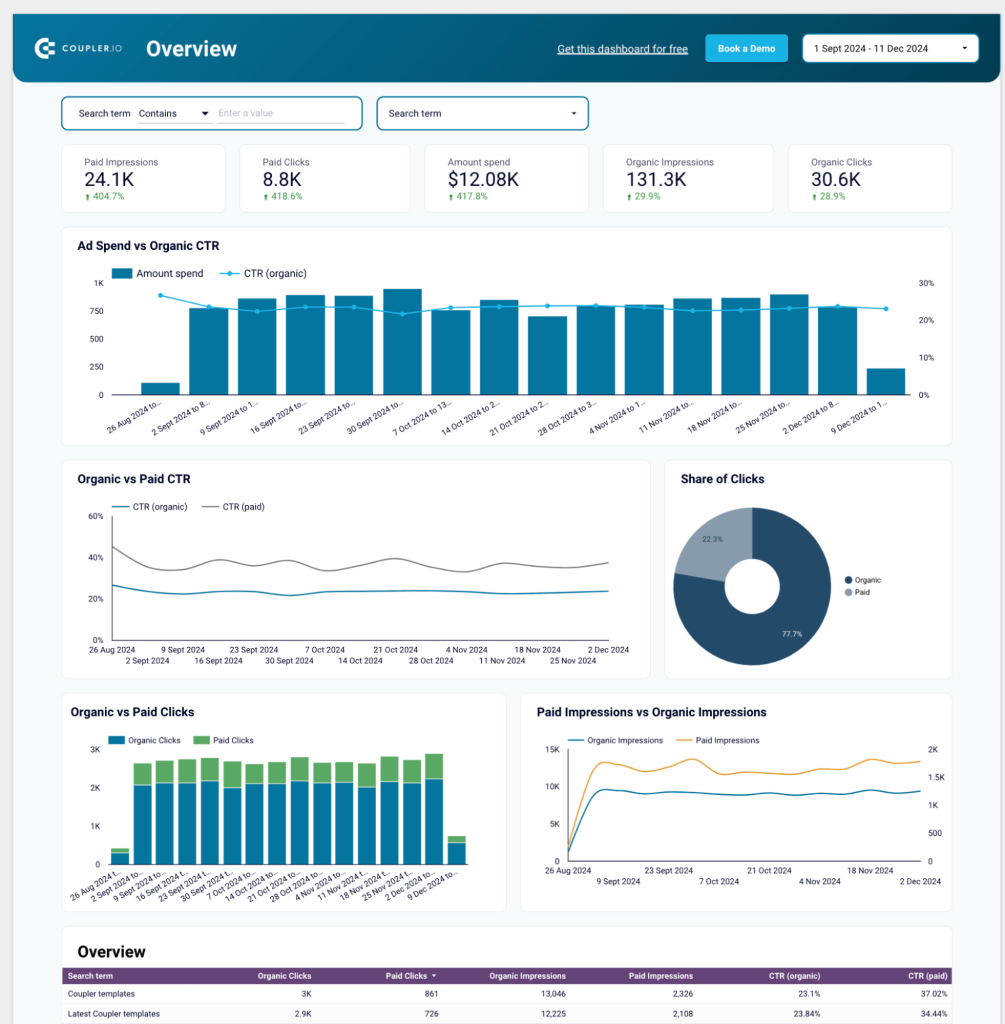
The dashboard shows the diversification between organic and paid traffic for brand keywords. As a result, you can see how much traffic you have gained and how much you have spent. Similarly, you can analyze specific topics to measure organic and paid traffic and make decisions like reducing costs if organic search drives more traffic than paid campaigns.
Google Analytics PPC dashboard
The Google Analytics and PPC dashboard can be especially insightful for e-commerce businesses. This will help you track your ROAS and understand how your PPC efforts impact sales.
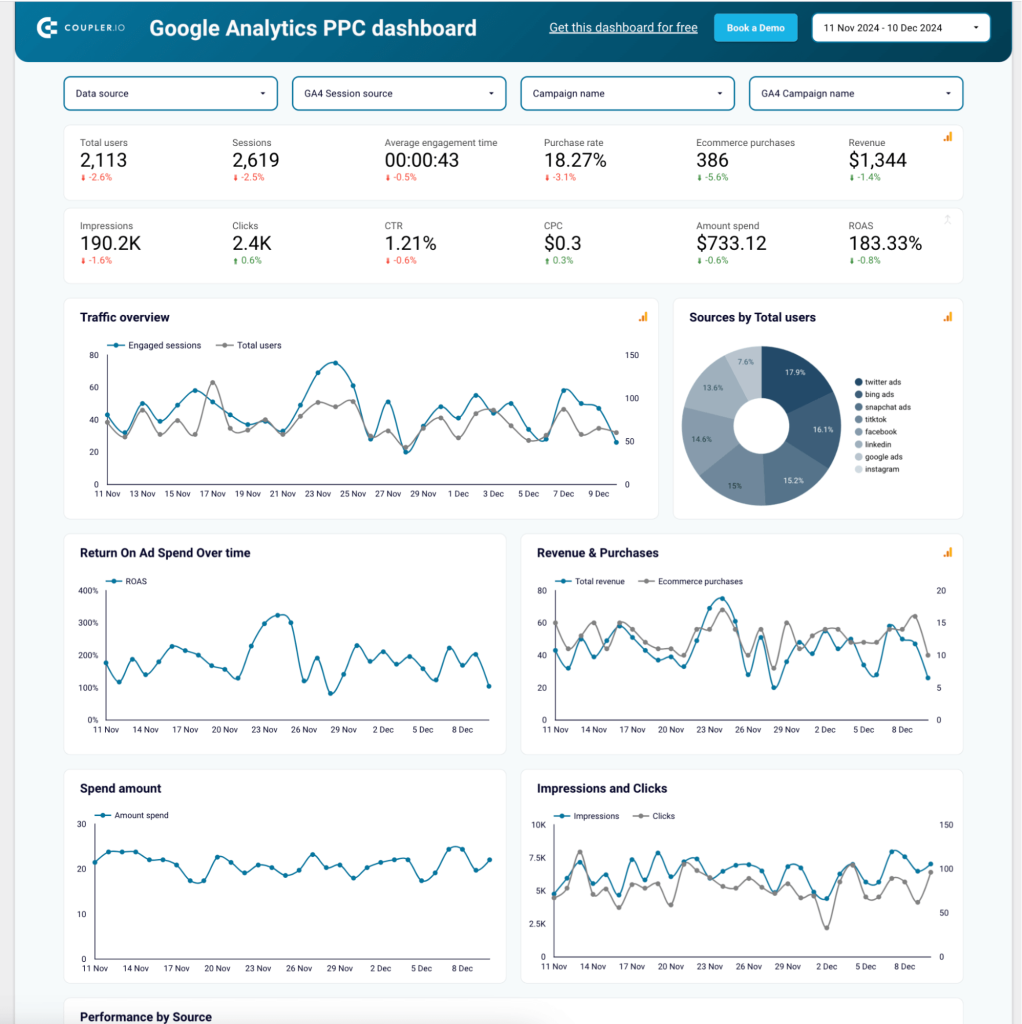
The dashboard is an optimum solution for cross-channel marketing analytics since it’s not limited to a single data source. You can connect Google Ads, TikTok Ads, LinkedIn Ads and other platforms to analyze the PPC performance like total users, purchase rate, revenue, or spend amount by source.
Brand awareness dashboard
If you’re looking to track the impact your PPC campaigns have on generating brand awareness, this dashboard is what you need. Use this to track ad clicks, ad spend and branded impressions and clicks from multiple PPC channels.
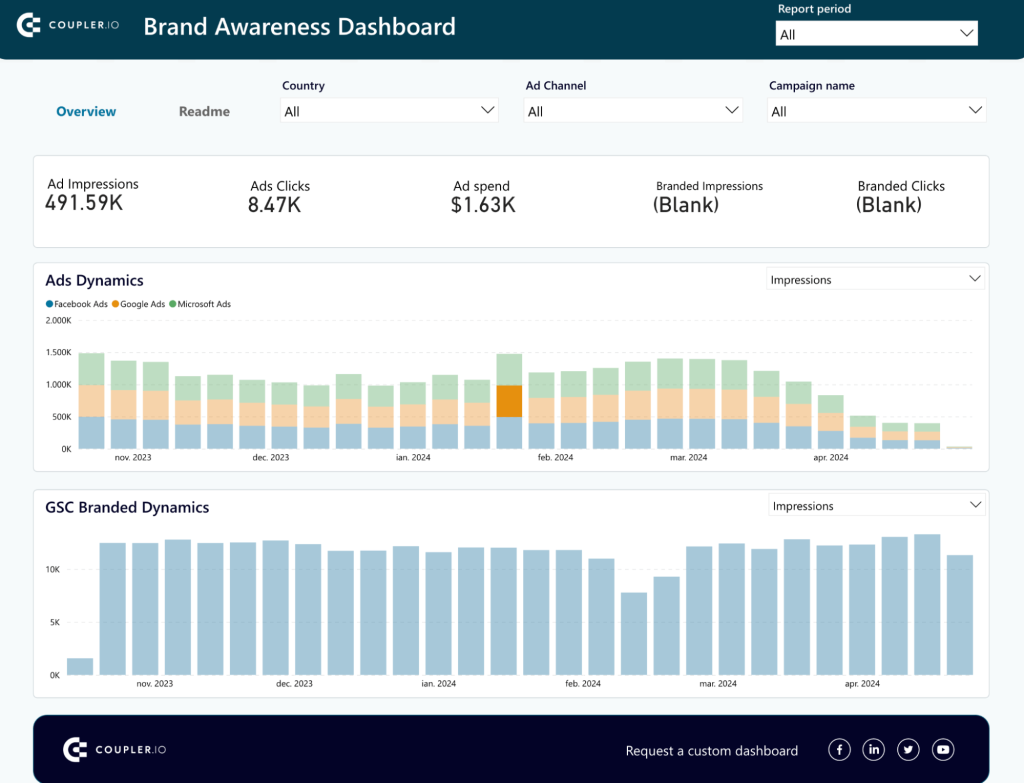
Customer acquisition funnel dashboard
For a full funnel overview, the Customer Acquisition Dashboard is a must. It helps you get a clear overview of how you are acquiring leads through PPC.
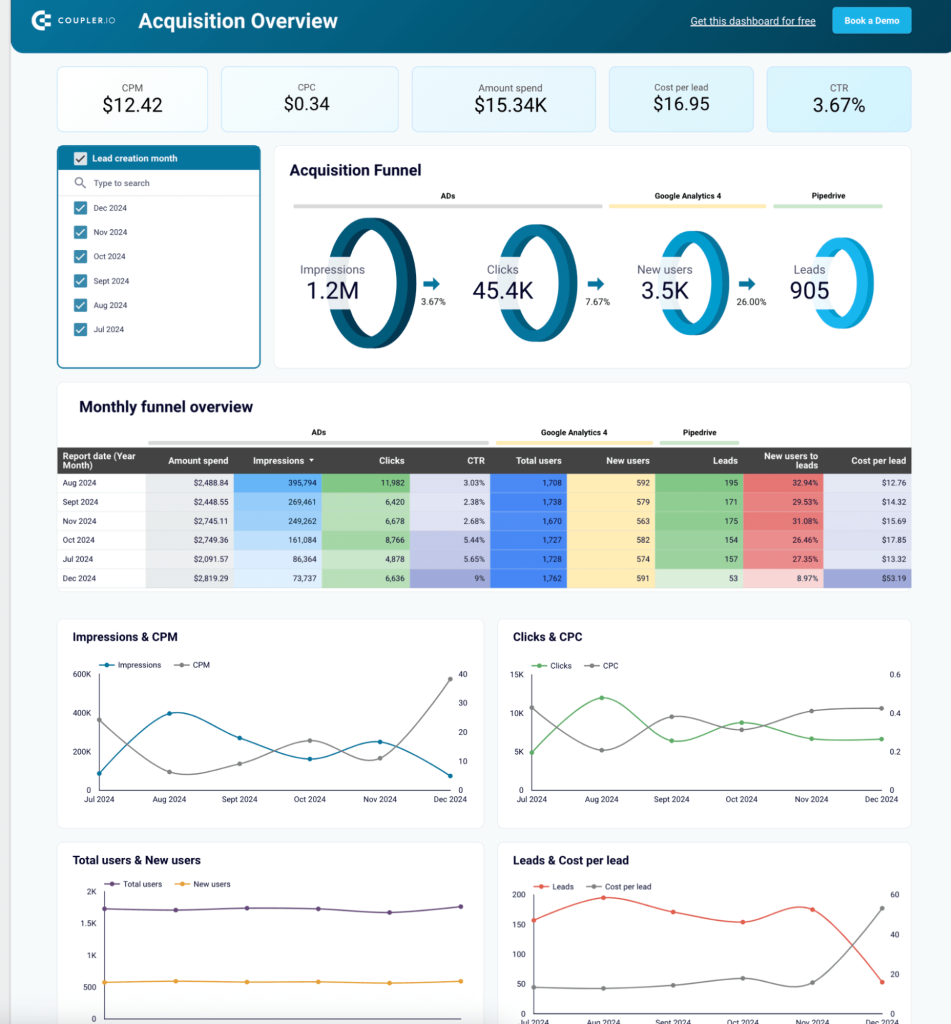
Use it to track metrics like CPM, CPC, and cost per lead, as well as ad budget spend across multiple channels.
Should you use SEO, PPC, or both in your marketing strategy?
The most effective strategy is to leverage both SEO and PPC as complementary strategies. While SEO builds long-term organic visibility and authority, PPC delivers immediate results and valuable insights you can use for testing and optimization.
Starting with PPC can generate quick insights and traffic, which can be beneficial while you gradually build up your SEO efforts. This balanced approach ensures you maintain visibility in search results while developing a strong organic presence that takes longer.
Choose which strategy to start with based on your budget and need, and remember to track performance to identify areas for improvement.

